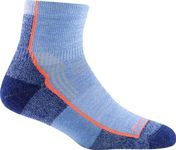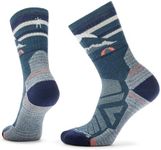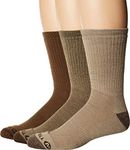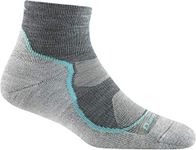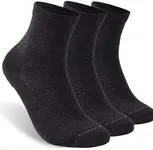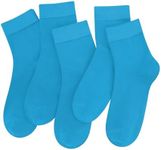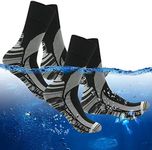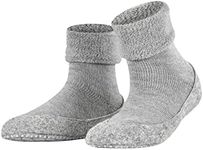Buying Guide for the Best Hiking Socks For Women
Choosing the right hiking socks is crucial for ensuring comfort, preventing blisters, and keeping your feet dry during your outdoor adventures. When selecting hiking socks, consider factors such as material, cushioning, fit, and additional features that can enhance your hiking experience. Here's a breakdown of key specifications to help you make an informed decision.MaterialThe material of hiking socks is important because it affects breathability, moisture-wicking, and durability. Common materials include merino wool, synthetic fibers, and blends. Merino wool is known for its softness, moisture-wicking properties, and temperature regulation, making it ideal for various weather conditions. Synthetic fibers like polyester and nylon are durable, quick-drying, and often more affordable. Blends combine the benefits of different materials. Choose a material based on your comfort preference and the typical weather conditions you'll be hiking in.
CushioningCushioning in hiking socks provides extra padding and support, which can help prevent blisters and reduce foot fatigue. Socks come in different levels of cushioning: light, medium, and heavy. Light cushioning is suitable for warm weather and shorter hikes, offering minimal padding. Medium cushioning provides a balance of comfort and support for moderate hikes. Heavy cushioning offers maximum padding for long hikes and rough terrain. Consider the length and difficulty of your hikes to determine the right level of cushioning for you.
FitA proper fit is essential to avoid discomfort and blisters. Hiking socks should fit snugly without being too tight. Look for socks with a contoured design that matches the shape of your foot and has reinforced areas around the heel and toe. Some socks also have arch support for added comfort. Make sure to try on socks with your hiking boots to ensure a good fit. If you have specific foot issues, such as high arches or wide feet, look for socks that cater to those needs.
HeightThe height of hiking socks can affect protection and comfort. Common heights include ankle, crew, and knee-high. Ankle socks are suitable for light hiking and warm weather, providing minimal coverage. Crew socks are the most popular choice, offering protection up to the mid-calf and suitable for most hiking conditions. Knee-high socks provide maximum coverage and are ideal for cold weather or areas with tall vegetation. Choose the height based on the type of terrain and weather conditions you'll be hiking in.
Moisture-wickingMoisture-wicking properties help keep your feet dry by drawing sweat away from the skin. This is important for preventing blisters and maintaining comfort during long hikes. Look for socks made from materials like merino wool or synthetic fibers that have good moisture-wicking capabilities. If you tend to sweat a lot or hike in humid conditions, prioritize socks with excellent moisture-wicking properties.
DurabilityDurability is important to ensure your hiking socks last through many adventures. Look for socks with reinforced areas, such as the heel and toe, which are prone to wear and tear. Materials like synthetic fibers and merino wool blends tend to be more durable. If you hike frequently or on rough terrain, choose socks that are known for their durability to get the best value and performance.


